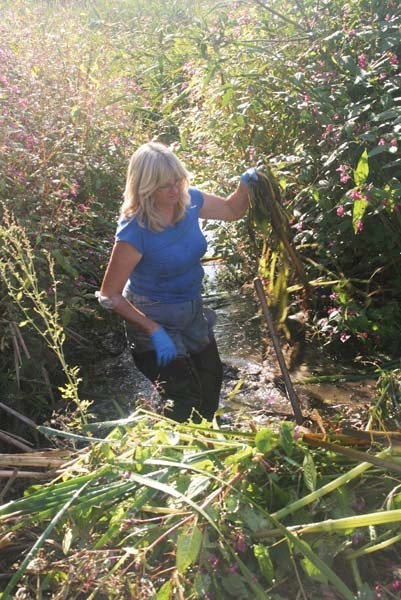An infestation of Himalayan Balsam is threatening the native plant species in Jessie Lake and putting the lake's ecosystem at risk.
On Friday, volunteers from the Town of Bonnyville, the MD of Bonnyville, and the Beaver River Watershed gathered on the shores of Jessie Lake to pull out stalks of the weed, hoping to slow the spread of the alien species and, after repeating efforts a few more times, eradicating it from Jessie Lake entirely.
Marsha Hayward, representative from the Alberta Native Plant Council, said the infestation of Himalayan Balsam is relatively recent. There was none of the plant in Jessie Lake two years ago.
“It's not common,” she said, standing up to her knees in water around the storm drain along the shore. “It's actually not supposed to be here at all. It's listed on the Provincial Weed Act as a noxious, inhibited species. It's not supposed to be sold or planted in people's gardens anywhere in Alberta. It's a prohibited weed.”
According to the Alberta Invasive Plant Council, Himalayan Balsam can grow up to three metres tall, which makes it more difficult for native species to receive the proper amount of sunshine, and grows at such a quick rate it can strangle other plants.
Its root system does not hold up well in winter, leading to advance levels of erosion, unlike native species, which have a stronger, deeper root system.
Himalayan Balsam also attracts pollinators away from the naturally occurring plants, according to information provided by the Alberta Invasive Plant Council.
The weed has hollow, red-purple stems between one and three metres tall, with serrated, lance-shaped leaves. Its flowers are between 2.5 and 4 centimetres long, and pink or purple, with five petals. Its seeds grow in pods that split open and eject the seeds on contact. It grows in moist soil.
The plant originated in the western Himalayas, spreading to Germany and Scandinavia by the mid-1900s. Now, it is listed as an invasive species across North America, Europe, Asia, and New Zealand.
If the plant is not dealt with, Hayward explained, the results could be disastrous.
“They will definitely take over and kill the lake,” she said. “The native plants, like the cattails, they actually clean the water and ingest the toxins and all the ducks and birds nest in the reed beds. They provide protection for the nests. It's amazing how much those native plants clean and siphon the bad stuff out.”
She added hand-pulling the weed is a control measure, and it will take more than one attempt to eradicate the weed. As stalks are being pulled from the ground, disturbed seedpods are erupting, spreading seeds as much as five metres from the parent plant.
The trick, Hayward explained, is to mark the spots where the weeds were pulled and come back next year, when the new plants are still seedlings and have not been germinated, and pull them up.
“We're probably going to have to do it annually until it's eradicated,” she said.
She added that the MD will definitely appreciate calls from anyone who wants to volunteer for future culling.
“We're trying to keep the lake nice,” she said. “That's the whole idea.”



